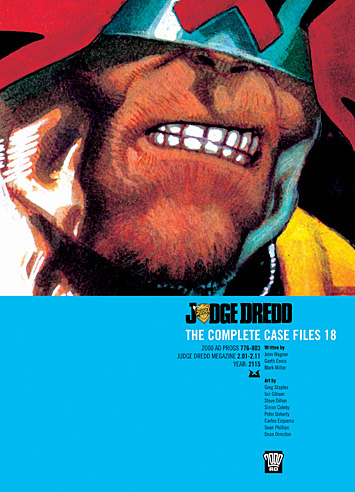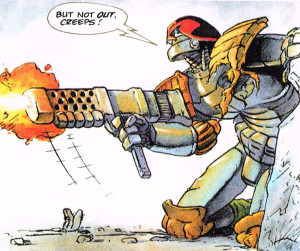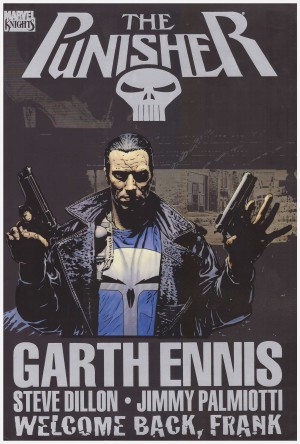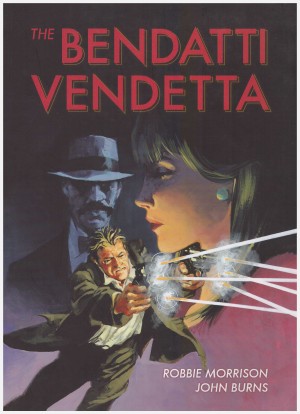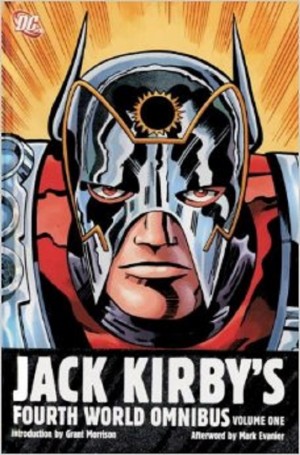Review by Roy Boyd
Case Files 18 is written by Garth Ennis and John Wagner, with solitary contributions from Alan Grant and Mark Millar. We begin with the four-part ‘Innocents Abroad’, ably illustrated by Greg Staples, followed by an Anthony Williams illustrated two-parter riffing on The Magic Roundabout. The next tale, ‘Raider’, has splendid artwork by John Burns that lends this five-parter, and Dredd’s world, a verisimilitude that it sometimes lacks in the hands of lesser artists.
Then we have a bunch of largely unremarkable stories, some featuring nice artwork (Ron Smith, Staples again, and Anthony Williams, who has improved noticeably). One story of note is ‘Happy Birthday Judge Dredd’, written by Mark Millar and illustrated by Carl Critchlow. The latter does a good job, especially with an impressive rendition of the Grand Hall of Justice. Sadly, the story is shit, and one is left wondering if the original punch-line was so offensive that it was changed. And if they don’t know that the title should have a comma before ‘Judge’, then I’m certainly not going to tell them.
Then we get to the book’s big hitter: the first of two Mechanismo stories. With wonderful artwork by Colin MacNeil, this employs a plot device from the very earliest days of Judge Dredd: demented robots run amok. The twist, in this case, is that the robots are Judges, programmed with personality traits of one Joseph Dredd. Which couldn’t possibly go wrong. This is something that Dredd forcefully points out to his superiors, who plunge ahead regardless. Well, the proverbial soon hits the fan and Dredd, given little time to gloat, has to face the massively powerful robots.
We then have another four stories of very little note, though the nightmarish John Hicklenton art in ‘Resyk Man’ pushes this collection into ‘mature readers’ territory, before, to complete this collection, ‘Mechanismo Returns’. Peter Doherty’s art is really good. It’s full of character and atmosphere, and is a perfect fit for a story that successfully mashes elements from Frankenstein, Pinocchio and the superb Brad Bird-directed The Iron Giant, eliciting sympathy from the reader for a homicidal killing machine. The Mechanismo tales also highlight divisions within the judges, a theme that Ennis repeatedly explores as a source of tension in Dredd’s world.
This collection has no credits for the Megazine stories. Creators are named, but there is nothing on the individual stories to tell you who did what. So you can play ‘guess the artist or writer’, or you can go to 2000ad.org to find out. And, just so you don’t have to, I can tell you that Wagner wrote all the un-credited stories in the Megazine section of the book, bar the aforementioned Hicklenton story, which was by Grant. The other artists are Barry Kitson (on the book’s second take on A Christmas Carol). Lastly, and leastly, Xuasus turns in some muddy work on ‘Warhog’ and ‘Deathmask’
The nature of this collection (over twenty stories) reduces half-a-dozen pages of reviewer’s notes to: ‘most of these stories are okay’. Ennis doesn’t have Wagner’s ability to write smashing little stories, and while the longer material is, by and large, the best, very few knock it out of the park.
Anyone wanting to sift this for the cream can find most in Judge Dredd: Mechanismo.
